BACKGROUND:
Students
have learned that minerals are identified by their key characteristics. In
this lab, students will record the hardness, specific gravity, and any other
characteristics that may be important for determining the use(s) of the
mineral.
Key characteristics are unchanging properties of a
substance. They can thus be reliably used to identify that substance.
Minerals have key characteristics. These include:
-
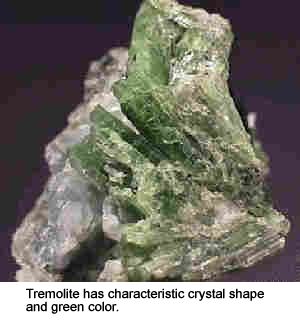 CRYSTAL FORM - The natural growth (shape) of a
mineral. Minerals take this shape whenever they are able to grow into
open space. The crystal form of a mineral often has many smooth, planar
surfaces called "faces" that meet at characteristics angles
(i.e., halite meets at right angles; quartz meets at 120 degrees). CRYSTAL FORM - The natural growth (shape) of a
mineral. Minerals take this shape whenever they are able to grow into
open space. The crystal form of a mineral often has many smooth, planar
surfaces called "faces" that meet at characteristics angles
(i.e., halite meets at right angles; quartz meets at 120 degrees).
-
FRACTURE AND CLEAVAGE -The way a mineral breaks.
Fracture is irregular breakage. For example, quartz has a conchoidal
fracture. Quartz breaks along hollowed and rounded, uneven surfaces.
Cleavage is a regular breakage that follows the atomic structure of a
mineral. Cleavage results in smooth, planar surfaces. Different minerals
may have one, two, three, four, or six cleavages.
-
HARDNESS - The mineral’s resistance to scratching.
It is controlled by the strength of atomic bonds within the mineral.
Mineral hardness is rated from 1 (soft) to 10 (hard) on the Mohs’
hardness scale.
-
SPECIFIC GRAVITY - The density of a mineral relative
to water. Metallic minerals often have high specific gravities.
-
STREAK - The color of a powdered mineral sample.
Streak is determined by scratching the mineral sample on a piece of
unglazed porcelain (a streak plate). Most metallic minerals produce a
colored streak.
-
LUSTER - The way that a mineral reflects light. There
are two types of luster. Metallic minerals look like shiny or rusted
metal. Nonmetallic elements reflect light like glass or pearls or glue.
-
TASTE - Certain minerals like halite (salty) and
sulfur (bitter) have characteristic "flavors."
-
MAGNETISM - The attraction of a mineral to a magnet.
-
REACTION TO ACID - The mineral reacts by
"fizzing" with dilute HCl reacts with carbonate minerals.
PROCEDURE:
-
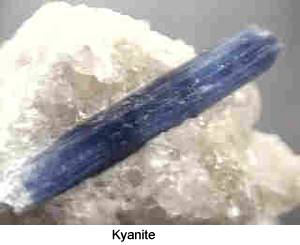 Before lab, prepare mineral specimen collections and testing materials
for each student group. Use the Rock Cycle - Minerals (6B) samples or
your own materials. If you are not familiar with any of the properties
discussed above, you may wish to experiment on your own before lab. Before lab, prepare mineral specimen collections and testing materials
for each student group. Use the Rock Cycle - Minerals (6B) samples or
your own materials. If you are not familiar with any of the properties
discussed above, you may wish to experiment on your own before lab.
-
Review the key characteristics of minerals. Discuss
with students how to determine each key characteristic. They should be
able to test for hardness, streak, specific gravity, and luster.
Magnetism and reaction to acid can be tested as well, if the proper
materials are available.
Hardness is determined by scratching the mineral with
a steel nail, a penny, and a fingernail. If a steel nail cannot scratch
the mineral, it is 6 or higher on the Moh’s Hardness Scale. If your
fingernail cannot scratch it, it is more than 2, and if the penny cannot
scratch it is more than 3.5 on the Mohs' scale. Students will thus be
able to roughly estimate hardness; this is exactly what geologists do
when conducting field research.
Streak is determined by scratching the mineral on the
porcelain plate. Most streaks are white and not very useful for
identification. However, most metallic minerals have colored streaks,
which are often a diagnostic characteristic.
Students will be able to distinguish the specific
gravity of a mineral as its being "heavy" (high specific
gravity) or "light" (low specific gravity). In general,
metallic elements will seem heavy.
-
Have the students work through the samples and try to
identify as many properties as possible for each mineral. Make sure they
record their observations.
-
On the worksheet, the chemical formula for the
minerals is also given. Students can look at the formula and see if
there are any useful elements within the structure of that mineral.
-
Here are some suggested answers:
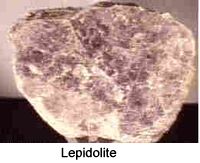 - Al2SiO5, hardness
5-7 (depending whether you scratch lengthwise); used in spark plugs and
porcelains - Al2SiO5, hardness
5-7 (depending whether you scratch lengthwise); used in spark plugs and
porcelains
FLUORITE - CaF2, hardness 4,
specific gravity 3.18; flux for making steel, used in the glass
industry, and as a source of fluorine for hydrofluoric acid
QUARTZ - SiO2, hardness 7, specific
gravity 2.65; used in clocks, glass, computers, abrasives, optical and
scientific apparatus
PYRITE - FeS2 (fold's gold); hardness
6-6.5; source of sulfur
GALENA - PbS (ore of lead); streak - lead gray;
specific gravity 7.4 - 7.6
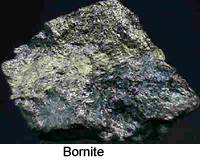 BORNITE - Cu5FeS4, ore of
copper; hardness 3; "peacock ore," bronze color, purple
tarnish, specific gravity around 5 BORNITE - Cu5FeS4, ore of
copper; hardness 3; "peacock ore," bronze color, purple
tarnish, specific gravity around 5
HEMATITE - Fe2O3, hardness
5.5-6.5 (used for red coloring in some make-up)
COPPER - Cu (used for tubing, etc.); hardness
2.5-3
ULEXITE - NaCaB5O9 8H2O;
hardness 2.5; crystallizes in arid region; a source of borax
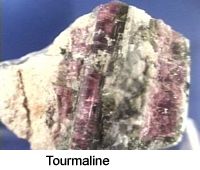 TOURMALINE IN LEPIDOLITE - Lepidolite K2Li3Al3
(AlSi3O10), hardness 2.5-4; color lilac, flat
cleavage, in small plates; source of lithium, used in heat resistant
glass TOURMALINE IN LEPIDOLITE - Lepidolite K2Li3Al3
(AlSi3O10), hardness 2.5-4; color lilac, flat
cleavage, in small plates; source of lithium, used in heat resistant
glass
TOURMALINE - complex silicate of boron and
aluminum; hardness 7-7.5, crystals usually prismatic, semiprecious gem
stone, pink tourmaline is known as rubellite; strong piezoelectric
property is used in the manufacture of pressure gauges.
|